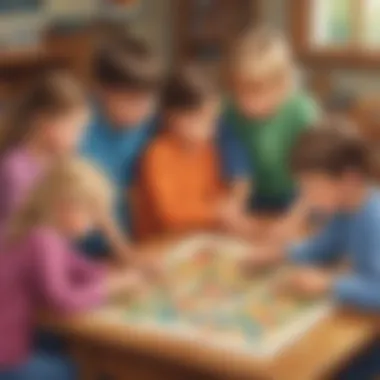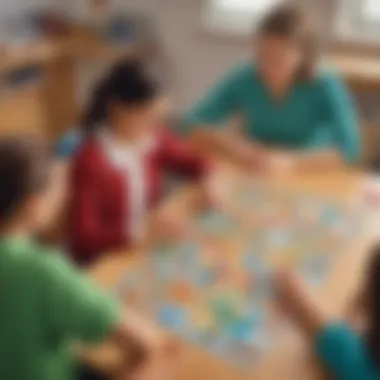Unraveling Sequence Puzzles: A Key to Children's Learning


Intro
Exploring sequence puzzles is an exciting journey into the world of cognitive development and educational engagement for young leaners. This article focuses on linking sequence puzzles as tools that enhance critical thinking and problem-solving abilities. Moreover, they cater to various age groups and integrate well into different learning styles, providing an adaptable resource for parents and teachers.
Sequence puzzles are not only entertaining but serve as instructional devices that drive comprehensive understanding. By delving deeper into aspects like interactive learning games, educational topics, practical tips, and hands-on projects, this article reveals how sequence puzzles can create more enriching learning environments for children.
Interactive Learning Games
Educational games capture young minds and stimulate their cognitive growth, enhancing their problem-solving skills.
Popular Games
Some widely accepted games that utilize sequence and logic include:
- Rush Hour – A vehicle gridlock puzzle
- Simon - Memory game that involves repetition of patterns
- Zingo - A Bingo-like card game that emphasizes sequences
Each of these games leverages the concept of sequences and provides layers of learning wrapped in enjoyable experiences.
Description of top educational games
Let's look closer at Rush Hour, a game that develops critical thinking through traffic jams, encouraging strategic planning.
In Simon, children enhances their memory and listening skills, requiring sequential pattern recognition.
Zingo employs visual matching based on sequences that boosts both recognition and quick thinking.
Benefits of playing educational games for kids' cognitive development
Engaging in these games fosters multiple skills:
- Analytical thinking: Identifying patterns and strategies
- Attention to detail: Noticing divergences in sequences
- Strategic planning: Forward-thinking solutions to win the game
By making gameplay educational, children learn cohesively with rewards tied to successful sequences.
Game Reviews
Educational games deserve thorough evaluation to understand their efficacy in learning contexts.
In-depth reviews of selected educational games
- Rush Hour: Fosters strategic thinking. Reviewers praise its engagement factor and how it encourages perseverance.
- Simon: Concise yet stimulating, fine-tunes auditory processing. Its popularity in classrooms is significant for memory training.
Comparison of gameplay and learning outcomes
While gameplay may vary, learning outcomes often converge over skills applied. Essentially, performance within these games directly influences cognitive alignment with academic expectations, providing a link between fun and education.
Educational Topics
Exploring sequence puzzles also brings forth various academic subjects, emphasizing interdisciplinary learning.
Compilation of articles covering various subjects like math, science, languages, etc.
This approach enables creativity while facilitating connections among math puzzles, language sequences, and scientific reasoning, honing critical thought in children.
Importance of interdisciplinary learning for holistic development
Integrative techniques support varied learning styles and encourage academic engagement by promoting interconnections between disciplines.
Tips and Tricks
To maximize the benefits sequence puzzles entail, parents and educators can employ several practical strategies.
Practical tips for parents and educators to enhance children's learning journey
- Start with small, age-appropriate puzzles – it ensures gradual familiarity.
- Provide a conducive learning environment with minimal distractions.
- Encourage group play – enhances collaboration and discussion.
Strategies for making learning fun and engaging
Set tangible goals ensures children stay motivated. Celebrate their successes to reinforce a love for sequential problem-solving.


Creative DIY Projects
Hands-on projects also breed creativity while developing vital skills. Building things physically translates learned concepts into tangible outcomes.
Step-by-Step Guides
Include projects where children assemble sequence puzzles collaboratively. Steps may involve choosing materials, sketching a layout, and execution.
Benefits of hands-on activities for children's cognitive and motor skills
These activities enhance sensory perceptions and also fortify motor coordination, fostering a deeper understanding of spatial concepts.
Craft Ideas
Creating sequence puzzles often uses everyday items. Children can make their own puzzles with:
- Paper plates for unique sequencing
- String for developing logic and patterns
Importance of artistic expression in children's development
Craft-based tasks contribute academically but nurture emotional vocabulary, enabling clearer communication.
In summary, sequence puzzles serve as a bridge between leisure and learning, engaging cognitive faculties while fueling creativity in young learners. Parents, educators, and children all have much to gain from exploring this interactive approach.
Understanding Sequence Puzzles
Understanding sequence puzzles is vital in comprehending their role and effectiveness as educational tools. These puzzles challenge learners to recognize patterns and relationships among elements, enhancing cognitive abilities. The benefits of sequence puzzles extend beyond mere recreation; they play a crucial role in cognitive development and learning reinforcement across various subjects.
By engaging with sequence puzzles, children enhance their thinking with skills that apply well to both academic and life scenarios. They nurture children’s analytical abilities, encouraging logical reasoning, patience, and attention to detail. This makes these educational tools particularly valuable in today’s diverse educational contexts.
Definition of Sequence Puzzles
Sequence puzzles are challenges that require learners to arrange elements in a specific order based on identifiable patterns. These elements can be numbers, letters, or visual components. The primary focus lies in recognizing the sequence’s underlying logic and applying it to reach a solution. This definition earns significance as it highlights the cognitive effort required in engaging with such puzzles, thereby promoting the development of critical thinking skills among young users.
Types of Sequence Puzzles
There are several prominent types of sequence puzzles that significantly contribute to learning processes.
Number Sequences
Number sequences involve arranging numbers in a particular order based on mathematical rules. This can include simple arithmetic patterns or more complex operations. These puzzles are popular because they reinforce mathematical concepts and promote an understanding of numerical relationships. A key characteristic of number sequences is their diverse application, appealing to different ages and skill levels. Kids can often draw on this familiarity with basic counting or moving to more challenging equations, enhancing both confidence and competence in mathematics.
Nevertheless, a downside exists as well. Some children may find numerical sequences intimidating, potentially leading to frustration rather than engagement. Maintaining an appropriate difficulty level is crucial for making number sequences a beneficial part of learning.
Letter Sequences
Letter sequences guide learners to recognize patterns among letters. Often, these puzzles involve completing sequences or identifying missing elements based on a specific logic related to the alphabet. Recognizing these patterns encourages them to develop literacy skills. Letter sequences are especially useful in early education to reinforce spelling and vocabulary. Their key advantage is making language more tangible; children can visualize and manipulate letters, which can significantly enhance their understanding of language.
However, it's essential to be cautious. Some students may sometimes feel overwhelmed while working with complex patterns involving letters. Sequencing letters effectively requires careful design to ensure educational goals are met without alienating the learner.
Visual Sequences
Visual sequences focus on arranging pictures or visual representations based on recognizable patterns. This type can capture the imagination, appealing to visual learners. A key aspect of visual sequences is that they allow learners to grasp abstract concepts through tangible visuals. The combination of art and logic can foster creativity, drawing connections between visual stimuli and logical reasoning.
However, visual sequences also present challenges. Not all children interpret visuals in the same manner. Misunderstandings can arise if learners struggle to see relationships among visual elements. Designers of these puzzles must be mindful of diverse interpretations to maximize benefits.
In summary, sequence puzzles encapsulate more than just fun. They are engaging avenues for reinforcing crucial cognitive skills among young learners. Providing varied forms of puzzles—numerical, alphabetical, and visual—ensures educators can cater to different learning styles and preferences.
The Importance of Sequence Puzzles in Learning
Sequence puzzles serve an important role in education, particularly in cultivating essential cognitive abilities among young learners. They not only enhance engagement but also foster critical thinking and problem-solving skills. The structure of these puzzles encourages children to recognize patterns, develop logic, and understand sequences in various forms. Through an active approach to learning, sequence puzzles allow for deeper comprehension of concepts that might be challenging in traditional learning methods.
Cognitive Development
Cognitive development is a vital component of early education. sequence puzzles support this by pushing children to think critically about the steps needed to complete them. This leads to the following key characteristics areas:
Enhancing Problem-Solving Skills
The first notable aspect of enhancing problem-solving skills through sequence puzzles includes encouraging children to investigate multiple solutions to a given problem. Rather than just finding an answer, they navigate possible paths and strategies, which is relevant to progressive learning. The ability to summon creativity within constraints is what makes this approach beneficial.


A unique feature lies in the gradual increase in complexity of sequence puzzles. Simple puzzles stimulate initial problem-solving capabilities, while more complex tasks promote advanced skills. One might consider that as a double-edged sword; if the puzzles are excessively difficult, frustration may occur.
Improving Logical Thinking
Improving logical thinking is another critical element in the spectrum of benefits associated with sequence puzzles. children engage in a mature thought process when tackling these challenges, which allows the developing mind to form connections between ideas and reasoning.
In educational settings, the prominence of such logical thinking exercises is indispensable. The emphasis on reasoning creates a robust framework for understanding other subjects, such as science and mathematics. However, without appropriate guidance from educators, variations in logical abilities may also pose a drawback. Children at different levels might experience difficulty keeping up, which necessitates careful consideration of balancing difficulty.
Skill Reinforcement
Skill reinforcement is an essential aspect of meaningful learning. Sequence puzzles intersect with various skills enhancement and provide a comprehensive learning experience.
Language Skills
Language development emerges as a prominent benefit from participating in sequence puzzles. Completing different sequences, particularly those related to stories or linguistic patterns, nurtures children’s vocabulary and grammatical understanding. This builds the foundation for effective communication, balking the notion of language skills being limited to rote memorization.
An intriguing aspect of language skills development is the interactivity amongst peers during group sequences activities. The collaborative effort not only bolsters social interaction but also further entrenches these acquired language concepts.
Mathematical Concepts
Turning to perhaps another crucial educational area: mathematical concepts also profit from the integration of sequence puzzles. The comprehension of numbers and operations' sequences provides a solid base for future studies in mathematics. Mastery of basic operations, such as addition or multiplication, frequently stems from recognizing patterns akin to those found in puzzles.
Utilizing visual and interactive puzzles enhances engagement. not all students comprehend numerical concepts uniformly. This differentiation may act as a disadvantage in mixed-ability classrooms, complicating the facilitation of a coherent learning experience for all. Nevertheless, targeting the content delivery toward each learner's needs remains achievable through thoughtful integration of various sequence puzzle types.
Sequence puzzles constitute a mosaic of advantages across different skills. Hence, considering the significance of versatility amidst potential challenges is crucial in educational strategy.
Integrating Sequence Puzzles into Educational Practices
Integrating sequence puzzles into educational practices provides a structured way for students to engage with critical thinking and problem-solving skills. This aspect is important because it encourages flexible thinking and adaptability among learners. Sequence puzzles can be incorporated in various ways, making them versatile tools for educators. The goal is to create inclusive environments where such puzzles stimulate creativity and reasoning.
Classroom Implementation
Classroom implementation involves two primary methods: group activities and individual challenges. Each method has its unique impacts and benefits.
Group Activities
Group activities leverage collaborative learning, enhancing social interaction among students. This approach allows children to share different strategies while solving puzzles. By working together, they are likely to develop their communication skills and interpersonal abilities. The key characteristic is the emphasis on teamwork and discussion, making it a popular choice in this educational setting. A unique feature of group activities is the diversity of thought that emerges. Each student can contribute distinct perspectives, leading to a deeper understanding of problem-solving.
However, there could be challenges as well. Group dynamics can sometimes cause distraction, meaning that the focus might shift away from the puzzles. Still, proper facilitation by educators can help strike the right balance.
Individual Challenges
Individual challenges focus on self-reliance and personal achievement. This method promotes independent learning, as each child grapples with puzzles on their own while developing their cognitive skills. The central feature of individual challenges is the opportunity for personal reflection, allowing students to grasp concepts more deeply. This focus often results in better retention of information and skills.
While this method empowers students, it could also create pressure to perform. Some children may feel disheartened if they struggle with particular puzzles. Guidance and encouragement are crucial in these cases to ensure that learning remains enjoyable and constructive.
Home Learning Strategies
Home learning strategies are effective methods to extend the reach of sequence puzzles beyond the classroom. Parents can integrate these puzzles into daily routines as part of their children's educational experiences.
Parent-Child Interactive Sessions
Parent-child interactive sessions focus on fostering a bond while also encouraging learning. This kind of engagement is beneficial because it allows parents to understand their children's learning styles and thought processes. The key feature here is the interaction between parent and child, smoothing the way for valuable discussions around puzzles. Through these moments, children can receive immediate feedback and encouragement, which often enhances their willingness to explore more complex sequences.
On the downside, parents may find it challenging to facilitate these sessions, especially if they are not familiar with such puzzles themselves. Nevertheless, learning together can result in more effective home learning environments.
Frequent Puzzle Challenges
Frequent puzzle challenges present an engaging way for kids to develop their skills gradually. This method encourages routine engagement with puzzles, promoting continuous cognitive development. The key characteristic of frequent challenges is the consistency that aids learning. A unique aspect is the ability to track progress over time. By observing children's advancements, parents can adjust the difficulty according to their child's current skill level.
However, introducing too many challenges at once can lead to frustration. Gradually increasing complexity while ensuring the child remains excited can offer a good compromise between challenge and enjoyment.
Engaging with sequence puzzles at home can significantly improve children's analytical skills while supporting family bonding.
Benefits of Sequence Puzzles
Boosting Engagement
Sequence puzzles can significantly boost engagement among young learners. When children encounter puzzles that require sequencing, they often become immersed in the challenge and motivated to find solutions. This pattern of engagement has direct implications for learning outcomes. The interactive nature of these puzzles both captures and holds attention.


Many children prefer activities that involve problem-solving rather than passive learning routines. Sequence puzzles provide a dynamic way to address this need. Instead of relying solely on traditional learning methods, these puzzles encourage exploration and active involvement.
Benefits include:
- Increased Critical Thinking: Working through puzzles nurtures analytical skills as children consider outcomes and options.
- Connections Made: Engagement in these activities facilitates discussions between peers and adults. This aids in solidifying knowledge through collaboration.
- Generates Curiosity: As learners are exposed to different puzzle formats, they become curious about other related topics, thus broadening their educational horizon.
Facilitating Independent Learning
Another vital aspect of sequence puzzles is their capacity for facilitating independent learning. Children often can tackle these puzzles alone or with minimal guidance, fostering a sense of independence and responsibility in their learning processes.
This self-direction is crucial for cognitive development and can set the stage for lifelong learning patterns. Independent puzzle-solving leads to:
- Enhanced Decision-Making: Navigating sequence puzzles involves making choices, indicating causality and potential outcomes – a skill vital for future scenarios.
- Boosting Confidence: Mastering a challenge provides clarity. Kids feel proud, increasing their self-esteem and willingness to tackle more puzzles.
- Adaptable Learning Levels: Sequence puzzles can be modified in terms of difficulty, allowing learners to progress at their own pace.
“The ability to learn independently works hand in hand with boosting engagement when it comes to sequence puzzles.”
Challenges in Using Sequence Puzzles
Sequence puzzles can be valuable educational tools, but implementing them effectively comes with its own set of challenges. These include ensuring that they are suitable for students of different ages and staying engaging enough to grasp their attention. It is crucial to address these difficulties, so educators and parents can maximize the benefits that sequence puzzles offer. Understanding difficulty levels and managing student engagement are critical components of using these puzzles in educational settings.
Difficulty Levels
Too Simple or Too Complex
Finding the right difficulty level for sequence puzzles can be a cornerstone of their educational value. If a puzzle is too simplistic, children may find it unchallenging, leading to boredom and disengagement. Conversely, a puzzle that is too complex can lead to frustration and a sense of defeat, hindering the learning process.
Key characteristics of suitable difficulty involve presenting problems that challenge intellect while still remaining accessible. A puzzle that offers appropriate challenges encourages persistence and problem-solving, making it a popular choice among educators looking to improve their students' cognitive skills.
The unique feature of balancing difficulty lies in the adaptability of the puzzles. For instance, educators might start with simpler sequences and gradually introduce more complex problems as students show readiness. This scaffolded approach supports learning by reinforcing the confidence and capabilities of young learners. However, finding this balance requires a keen understanding of each child's abilities and needs.
Student Engagement
Maintaining Interest
Maintaining a child's interest in sequence puzzles is vital for successful learning experiences. An engaging puzzle not only captures attention but fosters a positive attitude toward learning. With varying interests among students, an engaging sequence puzzle can be tailored to address different themes or formats.
A key charateristic of maintaining interest is providing variety. Using puzzles that incorporate various topics or formats, such as visual aids or interactive components, prevents monotony. This approach can make learning more enjoyable and deeply rooted as children relate the puzzles back to their lives and interests.
The unique feature of maintaining interest derives from creating an environment that encourages exploration and curiosity. As children interact with puzzles, their engagement will often lead them to seek out more complex challenges on their own. This autonomous exploration of sequence puzzles can result in improved critical thinking and overall cognitive development. However, it is essential to gauge whether a child's interest fluctuates to make timely adjustments, ensuring that these educational tools continue to captivate and inspire.
"Finding the right balance of difficulty and engagement in educational puzzles enhances cognitive skills while sustaining children's interest over time."
Future of Sequence Puzzles in Education
The future of sequence puzzles in education is promising, marked by rapid developments in technology and a growing recognition of their potential to cater to diverse learning needs. These puzzles can serve not only as engaging learning tools for young learners but also offer efficient methods for parents and educators to enhance cognitive skills across various age groups. Educational systems are increasingly adopting innovative approaches to learning, and sequence puzzles fit well into this progressive paradigm.
Technological Integration
Online Platforms
Online platforms have significantly revolutionized the way sequence puzzles are presented and consumed by learners. With vast repositories of interactive puzzles available, these platforms enhance engagement. Key characteristics of online platforms include accessibility and easy adaptability for different learning environments. The compelling nature of these puzzles attracts both children and educators, making them a preferred choice in modern educational setups.
The unique feature of online platforms is the ability to track progress and assess skills in real-time. This advantage permits educators and parents to tailor the learning experience according to the child's evolving capabilities. However, they may present disadvantages for those without reliable internet access, creating a gap in equitable learning opportunities.
Mobile Applications
Mobile applications have become another significant aspect of sequence puzzles in education. These apps not only provide instant access to a variety of puzzles but also promote learning on-the-go. The key characteristic of mobile applications lies in their portability and anytime accessibility, making them very beneficial for families and educators alike.
Moreover, mobile apps can be personalized, which adjusts difficulty levels to meet individual learner needs. This can foster a sense of achievement and success in solving puzzles. However, potential drawbacks include limitations in screen time due to health concerns, as well as reliance on device ownership, which can inhibit usage in less affluent circumstances.
Adaptation for Diverse Learners
Special Needs Considerations
Special needs considerations are vital in ensuring sequence puzzles are inclusive for all. These considerations include developing materials that are accessible for children with varied abilities. A key characteristic is the emphasis on adaptive instructions and supports, which makes it more useful in different learning environments. This approach not only improves access to educational resources but also fosters resilience and creativity in young learners.
Unique features might include visuals, audio cues, or tactile elements incorporated into puzzle design to cater to sensory needs. This enriches the educational experience effectively, although producing tailored materials can present challenges in terms of resources and training.
Multi-Lingual Accommodations
Multi-lingual accommodations are crucial as we strive for education that respects linguistic diversity. Classes with students from various language backgrounds can benefit greatly from sequence puzzles designed with multiple languages in mind. This key characteristic fosters inclusivity, expanding access for children who might otherwise feel left behind.
The unique features of this approach include puzzles which support language learning alongside cognitive skills development. They offer an opportunity to reinforce both sequencing and language skills in a practical setting. Nonetheless, the challenge lies in creating materials that effectively engage children while maintaining linguistic accuracy and making them culturally relevant.
By integrating both technology and targeted adaptations, sequence puzzles can transcend traditional learning barriers, providing enriching educational experiences tailored specifically for young learners.















